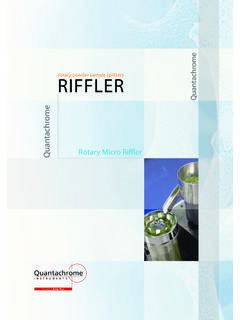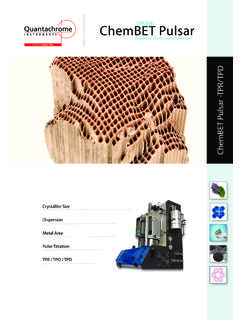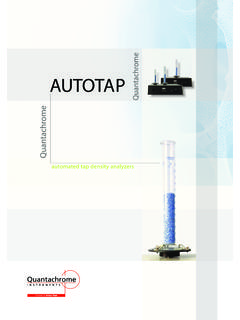Transcription of NOVA e SERIES - Quantachrome
1 novae SERIES HIGH-SPEED SURFACE AREA & PORE SIZE ANALYZERSA section of one greatly enlarged particle of a multilayer/ capillary condensation stage approximately 70% the density of the adsorbate, one can calculate the volume it occupies and, consequently, the total pore volume of the sample. If at this stage the adsorption process is reversed by withdrawing known amounts of gas from the system in steps, one generates desorption isotherms. The resulting hysteresis leads to isotherm shapes that can be related to those expected from particular pore performing gas sorption experi ments, solid surfaces must be freed from contaminants such as water and oils. Surface cleaning (degassing) is most often carried out by placing a sample of the solid in a glass cell and heating it under vacuum or flowing gas.
2 Figure 1 illustrates how a solid particle containing cracks and orifices (pores) of different sizes and shapes may look after its clean, the sample is brought to a constant temperature by means of an external bath. Then, small amounts of a gas (the adsorbate) are admitted in steps into the evacuated sample chamber. Gas molecules that stick to the surface of the solid (adsorbent) are said to be adsorbed and tend to form a thin layer that covers the entire adsor bent surface. Based on the well known Brunauer, Emmett and Teller ( ) theory, one can estimate the number of molecules required to cover the adsorbent surface with a monolayer of adsorbed molecules, Nm (see Figure 2). Multiplying Nm by the cross sectional area of an adsorbate molecule yields the sample s surface addition of gas molecules beyond monolayer formation leads to the gradual stacking of multiple layers (or multi layers).
3 The formation occurs in parallel to capillary condensation (see Figure 3). The latter process is appoxi mated by the Kelvin equation, which quantifies the proportionality between residual (or equilibrium) gas pressure and the size of capillaries capable of condensing gas within such as the classical one by Barrett, Joyner and Halenda ( ) or the more accurate Density Functional Theory (DFT) models, allow the computation of pore sizes from equilibrium gas pressures. Experimental isotherms of adsorbed gas volumes rel ative versus pressures (at equilibrium), are converted to cumulative or differen tial pore size the equilibrium adsorbate pressures approach saturation, the pores become completely filled with adsorbate (see Figure 4).
4 THE GAS SORPTION PROCESS Total pore volume filling; approximately 100% saturation. The monolayer of adsorbed molecules; approxi-mately 20% ServedParticle characterization technology serves a wide variety of industries, including:AerospaceAgricultureAutomotive AviationBatteriesBuilding MaterialsCeramicsChemicalsCommunications EquipmentConstructionConsumer GoodsCosmeticsElectrical & ElectronicsEnvironmental ServicesFoodsFood ProcessingFuel CellsManufacturingMarineMedical DevicesMetalsMining & MineralsMunitionsOil ExplorationOpticsPaints & CoatingsPaper & PackagingPetrochemicalsPharmaceuticalsPl asticsRubberTextilesWater TreatmentThe novae SERIES designed for today s laboratory.
5 Affordably priced perfect for any laboratory. Space saving each unit takes up less bench space than an open 3 ring binder. versatile a wide range of characterization techniques for powdered and porous materials. PC option use Windows based software or run stand 2200e rapid two sample surface area and pore size analyzer. Perform fully automated multi point analysis in as little as eight minutes (per sample). Eliminate the need for helium with patented NO Void Analysis ( nova ) technology. Analyze up to 200 data points (100 adsorption points and 100 desorption points). Prepare two samples by vacuum or flow methods simultaneously with sample analysis at different temperatures if required.
6 Access degasser during analysis to start/stop flow or vacuum degassing with Analysis Interrupt. Get data "on the fly" by uploading data to a PC from current analysis. Eliminate cell calibration with classical helium void volume mode. Transfer data via RS232 or printer port. Enhance performance with Windows compatible software. Verify performance with rapid calibration check. Usable with most non corrosive adsorbate gases such as argon, CO2 and light hydrocarbons over a wide range of temperatures. Provides higher laboratory efficiency and productivity. Flexible operation analysis type independent for each station (BET and /or pore size measurement). nova 4200e measures up to four samples simultaneously.
7 Analyze up to four samples at one time or three plus continuous Po measurement. Save space with four on board sample preparation ports. Plus all the capabilities of the nova e SERIES OVERVIEWC arbon for rubber, adsorbents (gas separation and water purification), gas masks, inks, laser printers and for the automotive, fertilizer, fuel cell and petrochemical materials for adhesives, chromatography, cosmetics, foodstuffs, detergents, explosives, ion exchange resins, pharma ceuticals and plastics. Minerals such as alumina, clays, hydroxyapatite, pigments, phosphates, silicas, zirconia, etc., used for abrasives, adsorbents, biomaterials, ceramics, cements, desiccants, fillers, papers and metals and ferrites for batteries, pressure formed/ sintered products, electronics, magnets and magnetic applications related to bone, composite materials, fibers, rigid foams, soil, sludge, slurries, suspensions and well for Quality Control and ResearchCoal ashNatural zeoliteCarbon blackQuantachrome s patented nova e SERIES offers a full line of high quality, high performance Surface Area and Pore Size Analyzers.
8 With eight fully automatic models to meet the needs of any research or quality assurance nova SERIES produces the results you Single and multi point surface area with y intercept, C constant, slope and correlation coefficient. Up to 100 adsorption and 100 desorption isotherm points. pore size distribution calculated from the adsorption or desorption isotherm. Total pore volume. Average pore with included NovaWin software Dubinin Radushkevich micropore area, average micropore width and adsorption energy. Langmuir surface area with slope, intercept, constant and correlation coefficient. Plot of single point surface area as a function of relative pressure. t method for micropore area and volume (Halsey, deBoer and carbon black methods).
9 Density Functional Theory calculations for unified micropore and mesopore size distri components of highest quality to ensure reliable results High sensitivity pressure transducer with excellent stability. Robust dewar elevator for years of trouble free operation. Filter gaskets to prevent vacuum system contamination by powdered samples. Reliable solenoid valves and leak free (10 9 cc/sec) dosing manifold. Sensitive HCLS coolant level sensorAccurate results require proper sample preparation Each station provides sample preparation under vacuum or flow condi tions. Backfill after vacuum degas with helium or adsorptive. Temperature range from ambient to 450 C* with independent selection.
10 Flow rate selection for each station. Optional, multi station degassing units for busy laboratories: MasterPrep, FloVac and XeriPrep Degassers.* 350 C standard with mantles supplied; 450 C with optional quartz heating mantlesNOVA e SERIESQUALITY CONTROL RESEARCHF eature highlights of the novae SERIES Functional Capability by ModelNOVA2200e Surface area analysis Mesopore size distribution Standard micropore methods Analysis stations Any Gas capability 2 NOVA4200e 4 Analysis selection keypadAutomated dewar elevatorVacuum or flow degassingHeating mantlesDegas temperature controlsStatus and data displayRS232 port for optional PC control via NOVAWin softwareSystem Status DisplayCoolantLevelSensor2 or 4 samplesGas Regulator Assembly Proper nova functioning is assured when high quality gas regulators are used.










